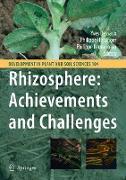- Start
- Rhizosphere: Achievements and Challenges
Rhizosphere: Achievements and Challenges
Angebote / Angebote:
Described by Hiltner over a century ago (1904), the rhizosphere is defined as the fraction of soil influenced by plant root activities. This dynamic, complex interface where soil, plant roots and microbes interact is a major hotspot of microbial activity, where numerous subtle molecular processes, as well as multiple feedback events take place, Rhizosphere investigations at the microscopic scale have driven spectacular academic advances in the fields of soil sciences or plant-microbe interactions. They bear promises in terms of environmentally-friendly procedures such as bioremediation or ecological engineering. The long recognized role of rhizosphere processes in plant nutrition and health, and more generally in plant adaptation to stress conditions, is now becoming central for designing sustainable management practices of agricultural and forest ecosystems. The rhizosphere, however, must also be considered and investigated at a much larger scale than its own, especially as a location where important steps of both carbon and nitrogen cycles occur, with obvious links with global changes. Major advances in understanding the rhizosphere have been achieved over the last two decades. Combined expertise in plant biology, microbial ecology and soil sciences and design of research strategies including the latest innovative methods in these fields opens exciting prospects for the future.
Lieferbar in ca. 20-45 Arbeitstagen
